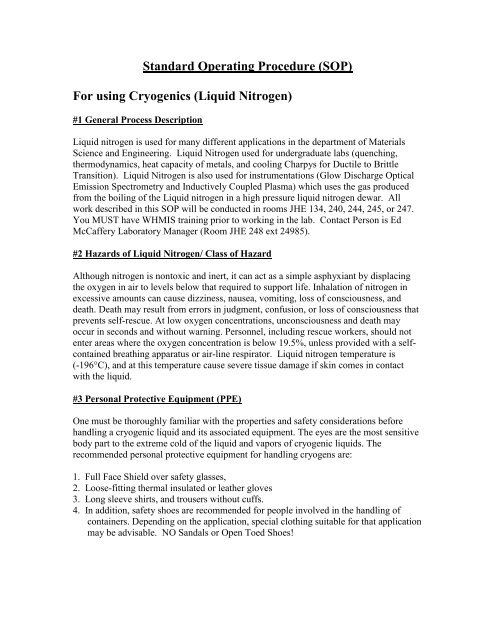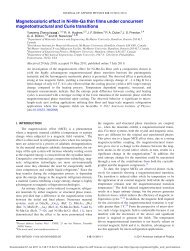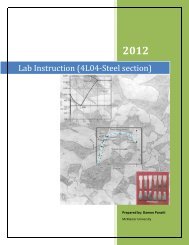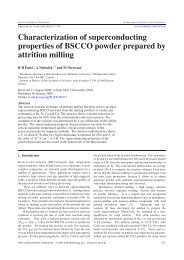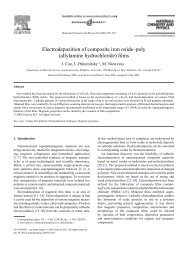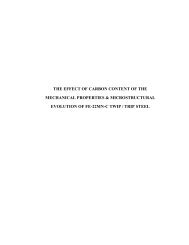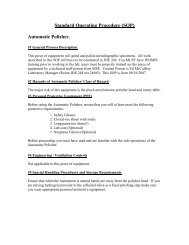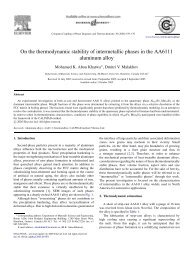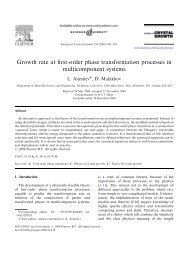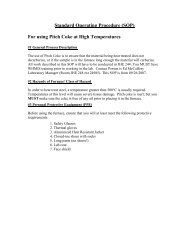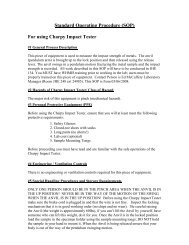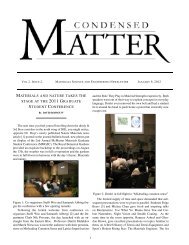Standard Operating Procedure (SOP) - McMaster Department of ...
Standard Operating Procedure (SOP) - McMaster Department of ...
Standard Operating Procedure (SOP) - McMaster Department of ...
You also want an ePaper? Increase the reach of your titles
YUMPU automatically turns print PDFs into web optimized ePapers that Google loves.
<strong>Standard</strong> <strong>Operating</strong> <strong>Procedure</strong> (<strong>SOP</strong>)<br />
For using Cryogenics (Liquid Nitrogen)<br />
#1 General Process Description<br />
Liquid nitrogen is used for many different applications in the department <strong>of</strong> Materials<br />
Science and Engineering. Liquid Nitrogen used for undergraduate labs (quenching,<br />
thermodynamics, heat capacity <strong>of</strong> metals, and cooling Charpys for Ductile to Brittle<br />
Transition). Liquid Nitrogen is also used for instrumentations (Glow Discharge Optical<br />
Emission Spectrometry and Inductively Coupled Plasma) which uses the gas produced<br />
from the boiling <strong>of</strong> the Liquid nitrogen in a high pressure liquid nitrogen dewar. All<br />
work described in this <strong>SOP</strong> will be conducted in rooms JHE 134, 240, 244, 245, or 247.<br />
You MUST have WHMIS training prior to working in the lab. Contact Person is Ed<br />
McCaffery Laboratory Manager (Room JHE 248 ext 24985).<br />
#2 Hazards <strong>of</strong> Liquid Nitrogen/ Class <strong>of</strong> Hazard<br />
Although nitrogen is nontoxic and inert, it can act as a simple asphyxiant by displacing<br />
the oxygen in air to levels below that required to support life. Inhalation <strong>of</strong> nitrogen in<br />
excessive amounts can cause dizziness, nausea, vomiting, loss <strong>of</strong> consciousness, and<br />
death. Death may result from errors in judgment, confusion, or loss <strong>of</strong> consciousness that<br />
prevents self-rescue. At low oxygen concentrations, unconsciousness and death may<br />
occur in seconds and without warning. Personnel, including rescue workers, should not<br />
enter areas where the oxygen concentration is below 19.5%, unless provided with a selfcontained<br />
breathing apparatus or air-line respirator. Liquid nitrogen temperature is<br />
(-196°C), and at this temperature cause severe tissue damage if skin comes in contact<br />
with the liquid.<br />
#3 Personal Protective Equipment (PPE)<br />
One must be thoroughly familiar with the properties and safety considerations before<br />
handling a cryogenic liquid and its associated equipment. The eyes are the most sensitive<br />
body part to the extreme cold <strong>of</strong> the liquid and vapors <strong>of</strong> cryogenic liquids. The<br />
recommended personal protective equipment for handling cryogens are:<br />
1. Full Face Shield over safety glasses,<br />
2. Loose-fitting thermal insulated or leather gloves<br />
3. Long sleeve shirts, and trousers without cuffs.<br />
4. In addition, safety shoes are recommended for people involved in the handling <strong>of</strong><br />
containers. Depending on the application, special clothing suitable for that application<br />
may be advisable. NO Sandals or Open Toed Shoes!
<strong>SOP</strong> – Liquid Nitrogen.<br />
A special note on insulated gloves: Gloves should be loose-fitting so they are able to<br />
be quickly removed if cryogenic liquid is spilled on them. Insulated gloves are not<br />
made to permit the hands to be put into a cryogenic liquid. They will only provide<br />
short-term protection from accidental contact with the liquid. In emergency situations,<br />
self-contained breathing apparatus (SCBA) may be required.<br />
#4 Engineering / Ventilation Controls<br />
Store and use this product with adequate ventilation. Do not store in a confined space.<br />
Cryogenic containers are equipped with pressure relief devices to control internal<br />
pressure<br />
#5 Special Handling <strong>Procedure</strong>s and Storage Requirements<br />
Under normal conditions, these containers will periodically vent product. Do not plug,<br />
remove, or tamper with any pressure relief device. Never allow any unprotected part <strong>of</strong><br />
the body to come in contact with uninsulated pipes or equipment that contains cryogenic<br />
product. The extremely cold metal will cause the flesh to stick fast and tear when one<br />
attempts to withdraw from it. Use a suitable hand truck for container movement.<br />
Containers should be handled and stored in an upright position. Do not drop, tip, or roll<br />
containers on their sides. Do not remove or interchange connections. Contact the vendor<br />
if you experience any difficulty operating the container valve or with the container<br />
connections. Discontinue use. Use the proper connection. DO NOT USE ADAPTERS!<br />
Use piping and equipment designed to withstand the pressures to be encountered. On gas<br />
withdrawal systems, use a check valve or other protective apparatus in any line or piping<br />
from the container to prevent reverse flow. To prevent cryogenic liquids or cold gas from<br />
being trapped in piping between valves, the piping should be equipped with pressure<br />
relief devices. Only transfer lines designed for use with cryogenic liquids should be used.<br />
Some elastomers and metals such as carbon steel may become brittle at low temperatures<br />
and will easily fracture. These materials must be avoided in cryogenic service. It is<br />
recommended that all vents be piped to the exterior <strong>of</strong> the building or to a well ventilated<br />
indoor space.
<strong>SOP</strong> – Liquid Nitrogen.<br />
#6 Accident <strong>Procedure</strong>s<br />
People suffering from lack <strong>of</strong> oxygen should be moved to fresh air. If the victim is not<br />
breathing, administer artificial respiration have someone call 88. If breathing is difficult,<br />
administer oxygen. Obtain immediate medical attention. Self-contained breathing<br />
apparatus (SCBA) may be required to prevent asphyxiation <strong>of</strong> rescue personnel.<br />
For skin contact with cryogenic liquid nitrogen, remove any clothing that may restrict<br />
circulation to the frozen area. Do not rub frozen parts, as tissue damage may result. As<br />
soon as practical, place the affected area in a warm water bath that has a temperature not<br />
in excess <strong>of</strong> 105°F (40°C). Never use dry heat. Call a physician as soon as possible.<br />
Frozen tissue is painless and appears waxy with a possible yellow color. It will become<br />
swollen, painful, and prone to infection when thawed. If the frozen part <strong>of</strong> the body has<br />
been thawed, cover the area with a dry sterile dressing with a large bulky protective<br />
covering, pending medical care. In the case <strong>of</strong> massive exposure, remove clothing while<br />
showering the victim with warm water. Call a physician immediately.<br />
If the eyes are exposed to the extreme cold <strong>of</strong> the liquid nitrogen or its vapors,<br />
immediately warm the frostbite area with warm water not exceeding 105°F (40°C) and<br />
seek immediate medical attention.<br />
Contact Emergency Response (88), then and Lisa Morine Ext 23314 and Ed McCaffery<br />
Ext 24895.<br />
#7 Waste Disposal<br />
Not Applicable<br />
#8 Training requirements<br />
Prior to entering and working in the laboratory, you must have completed the EOHSS<br />
WHMIS training. You will have to retain training documentation for at least one year.<br />
Any person conducting work using this <strong>SOP</strong> must receive training on the contents <strong>of</strong> this<br />
<strong>SOP</strong>.<br />
#9 Approval Required<br />
All research staff must be trained prior to starting work with the cryogenics. Under no<br />
circumstances it is allowed to work with the liquid nitrogen, while being alone in the<br />
laboratory. Always ask a second person to be in the lab with you. If you have to work<br />
with liquid nitrogen and you are alone, you have to ask for approval from your<br />
Supervisor then Laboratory Manager Ed McCaffery.<br />
#10 Decontamination<br />
N/A.
<strong>SOP</strong> – Liquid Nitrogen.<br />
#11 Designated Area<br />
Upon leaving a designated work area, remove any personal protective equipment worn<br />
and wash hands. After each use (or day), wipe down the immediate work area. At the end<br />
<strong>of</strong> each project, thoroughly decontaminate the designated area before resuming normal<br />
laboratory work in the area.<br />
#12 Precise Process Description<br />
Always handle cryogenic liquids carefully. Their extremely low temperatures can<br />
produce cryogenic burns <strong>of</strong> the skin and freeze underlying tissue. When spilled on<br />
a surface, they tend to spread as far as the quantity <strong>of</strong> liquid spilled and the<br />
physical confines <strong>of</strong> the area permit. They can cool large areas. The vapors<br />
coming from these liquids are also extremely cold and can produce burns.<br />
Exposure to these cold gases, which is too brief to affect the skin <strong>of</strong> the face or<br />
hands, may affect delicate tissues, such as the eyes. Stand clear <strong>of</strong> boiling and<br />
splashing liquid and the cold vapors that are released. Boiling and splashing<br />
always occur when filling a warm container or when inserting objects into the<br />
liquid. Always perform these operations slowly to minimize the splashing and<br />
boiling. Never allow any unprotected part <strong>of</strong> your body to touch uninsulated pipes<br />
or vessels containing cryogenic liquids. The extremely cold material may stick<br />
fast to skin and tear the flesh when you attempt to withdraw it. Even nonmetallic<br />
materials are dangerous to touch at these low temperatures. Use tongs to immerse<br />
and remove objects from cryogenic liquids. In addition to the hazards <strong>of</strong> frostbite<br />
or flesh sticking to cold materials, objects that are s<strong>of</strong>t and pliable at room<br />
temperature, such as rubber or plastics, are easily broken because they turn brittle<br />
at low temperatures and may break when stressed.
<strong>SOP</strong> – Liquid Nitrogen.<br />
Laboratory Spill Response <strong>Procedure</strong>s<br />
Health Threatening Situation - In the event <strong>of</strong> an imminent or actual health-threatening<br />
emergency (threatening local or public health, safety, or welfare; or the environment<br />
outside the immediate area):<br />
1) CALL 88 FOR THE EMERGENCY RESPONSE<br />
REMAIN IN THE AREA TO ADVISE RESPONDERS.<br />
2) ACTIVATE LOCAL ALARM SYSTEMS<br />
3) Once personal safety is established, call EOHSS at Ext 24352 and proceed with<br />
local notifications, below.<br />
Non-Health Threatening Situation – In the event <strong>of</strong> a major burn or asphyxiation:<br />
1) Notify <strong>McMaster</strong> Responders: Call 88 (24 hours/day, 7 days/week), then<br />
2) Provide local notifications:<br />
Name Phone Number Title<br />
Ed McCaffery Ext 24895 Lab Manager/ Principal Investigator<br />
Lisa Morine Ext 23314 EOHSS<br />
Local Response Situation – In the event <strong>of</strong> a minor burn:<br />
1) Notify personnel in the area and restrict access.<br />
Disclaimer: The <strong>SOP</strong> as written contains our best understanding at this time on how to<br />
work safely with this piece <strong>of</strong> equipment. When new information is found that would<br />
improve the safe use <strong>of</strong> this equipment it will be added in a timely manner. As it stands<br />
we cannot be held liable for misuse or abuse <strong>of</strong> these instructions through negligence on<br />
the user’s part or based on the content <strong>of</strong> these notes.


